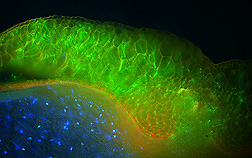This page has been archived and is being provided for reference purposes only. The page is no longer being updated, and therefore, links on the page may be invalid.
|
Read the magazine story to find out more. |
|
|
|
|
Scientists Identify Specific Barley Tissues Infected by Scab
By Stephanie Yao
February 22, 2010
Recent studies involving the fungus that causes the disease known as scab in barley have helped Agricultural Research Service (ARS) scientists identify the specific tissues the fungus infects.
The fungus Fusarium graminearum is the culprit behind scab in barley and wheat grain crops. Scab reduces yield by causing sterility and shrunken kernels, and contaminates the grain with mycotoxins.
Plant molecular geneticist Ron Skadsen at the ARS Cereal Crops Research Unit in Madison, Wis., infected barley seed spikes with Fusarium transformed to contain a green fluorescent protein that makes the fungus glow neon-green when examined under a fluorescence microscope. He found that Fusarium attacks the protruding seed tip of the developing seed, the soft tissue connected with it (just under the hull) and, to a lesser extent, the seed’s outer hull.
Previous studies using detached barley seeds found that the fungus will liquefy the starchy interior of the seed within five days after inoculation. Skadsen found that, even 16 days after infection, Fusarium doesn’t penetrate the starchy endosperm when the seed remains attached to the spike.
Knowing which parts of the barley plant Fusarium attacks gives insight into how the infection process works and where to target breeding and biotechnology strategies, according to Skadsen. Breeders can now focus on looking for traits that will prevent the fungus’ early penetration.
These findings helped Skadsen and his research team to develop gene promoters that can be used to activate genes that defend against Fusarium in barley’s susceptible tissues. Skadsen and research leader Cynthia Henson are now investigating the biochemistry of susceptible barley tissues through metabolic profiling during the first three days of infection.
Read more about this research in the February 2010 issue of Agricultural Research magazine.
Details of the studies can be found in the scientific journals Physiological and Molecular Plant Pathology, Plant Molecular Biology and Plant Biotechnology Journal.
ARS is the principal intramural scientific research agency of the U.S. Department of Agriculture (USDA). This research is part of the U.S. Wheat and Barley Scab Initiative and supports the USDA priority of promoting international food security.

